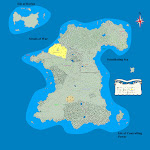The period known as the Era of Humanity represents the transition from primalistic and tribal societies, with rampant elementalism and shamanism, to one of a higher, more modern society. All of the races went thru this transition at the same time, more or less. The dwarves worshipped earth spirits, the elves were mostly in thrall to the Fey, and the orcs held an awe for many spirits of the dead.
Technologically, the race of humans were the driving force for development. They typically acquired technology from other races (woodcrafting and magic from the elves, mining and metallurgy from the dwarves) and synthesized new uses for it (iron-working, for instance; previously the dwarves could smelt iron, but did not use it for tools or weaponry).
The gnomes and halflings were content to mix freely with the other races, living amongst them, and acting as a conduit for trade and the exchange of ideas.
The Dawn of Man
Some time after the Dragon Wars, a new race appeared on Eninn – the race of Humans. Some say they were inter-dimensional refugees, others that they were the new children of Enchantra, but regardless, they quickly formed tribes and spread out across the continent. For the most part, the old races shunned these newcomers as savages and uncultured barbarians. The tribes of man warred with one another, and sometimes with the older races.
Eventually the tribes would be united under regional chieftains: The Three Sultans in the region now known as the Bloodcoast, Chief Huri in the central region, known as Muriah and Lucias the Pious in the southeast, now known as the Holy Empire of Astalon, and Yond the Great in the Dyninn region. Villages formed into towns, which became the first human cities: Astalon, Paragon (then known as Caerganon), Tourmaline (then known as Casule-on-Dovons), and Arroch.
Dawn of Magic
Magic has always been used by the sentient races to some degree: many of the pre-cursor races had always had an inherent ability with magic. With the end of the Dragon-Wars, though, these races soon found their abilities beginning to wane. The races of man and elf, orc and dwarf, would have to find new ways of piercing the veil and working magic.
During this period, the existence of the Veil was first discovered, and the primary tenants of magic first codified. The idea of ‘schools’ of magic was also developed. Magic was wild and barely controlled during this time; a dangerous topic for study. Experiments with magical artifacts, both divine and arcane, were performed, yielding items of interest and power, both cursed and benign. Some of the most raw and powerful items of lore stem from this period.
Dawn of War
This age, also known as the Endless War, began with the discovery of the process for forging iron. The deep dwarves had long known the secret to metalcrafting, but its discovery by the surface races heralded an era of almost constant conflict. The powerful tribes fought each other, and at times themselves, in constant wars, civil uprisings, and skirmishes that unleashed new weaponry and magics that would change the world forever.
This era would end with the tenuous unification of the tribes under one ruler: Chief Huri XV, later dubbed the First King of Muriah. He was also the first human to strike a deal with the High Elves of the North, and the Elves of Myrh, who were key in his conquests of his human neighbors.
Dawn of Civilization/The Godwars
The Era of Humanity is typically said to end during the troubling time of the Godwars. Civilization had been burgeoning, despite the strife and ruin of the endless conflicts of the previous 500 years. With it, new religions had been founded, disbanded, and started anew. Humans, and many of the other races, had begun seeking more from the world, and this desire for the numinous had called other deities to the world of Eninn.
These new deities all sought followers amongst the mortals; no sentient race was innocent of seeking out a new order in their complex worlds. The old deities: Sunia, Hele and Solis mostly, had strong followings that resisted the changing world order, but these deities were typically not concerned with many of the new aspects of civilization, or even ethical dilemmas that the new races were facing.
Thus began a time of conflict that had not been seen since the Cataclysm. It all began simply enough: followers of the Sun-cult succeeded in summoning the Avatar of Solis. This breach in the Veil would allow all of the deities, interested in gaining foothold in the lands, to pierce the Veil, and manifest themselves on the world. Beings of immense power, they sought to defeat the followers of one another. These wars often ignored political boundaries, and entire cities were razed by the religious zeal rampant in this time.
The followers of Enchantra were eager to stem the tide of magic flowing into the world, for they foresaw the consequences: if the Veil was not mended, the entire world would be consumed by the chaotic energies of the Void. Enchantra herself gave birth to offspring, to aid her in tending the Veil: Illias and Nostalus, who both took on the portfolios of magic tinged with ethics. During this time, magic was chaotic and uncontrolled, and many races found their own native latent abilities burgeoning.
Many other deities conceived, bore, or created children, both to meet the needs of their followers, and to battle the foreign deities seeking to usurp their world. Some of these demigods survived, but many did not, destroyed in the fights that raged.
The wars were brief. Some say they actually raged for eons, but that Chronos stepped in at their conclusion and erased the years of destruction, condensing them to a single year. Regardless, the Godwars changed everyone’s outlook on faith, ethics, and the Gods themselves, and established many new religions on the face of Eninn.
